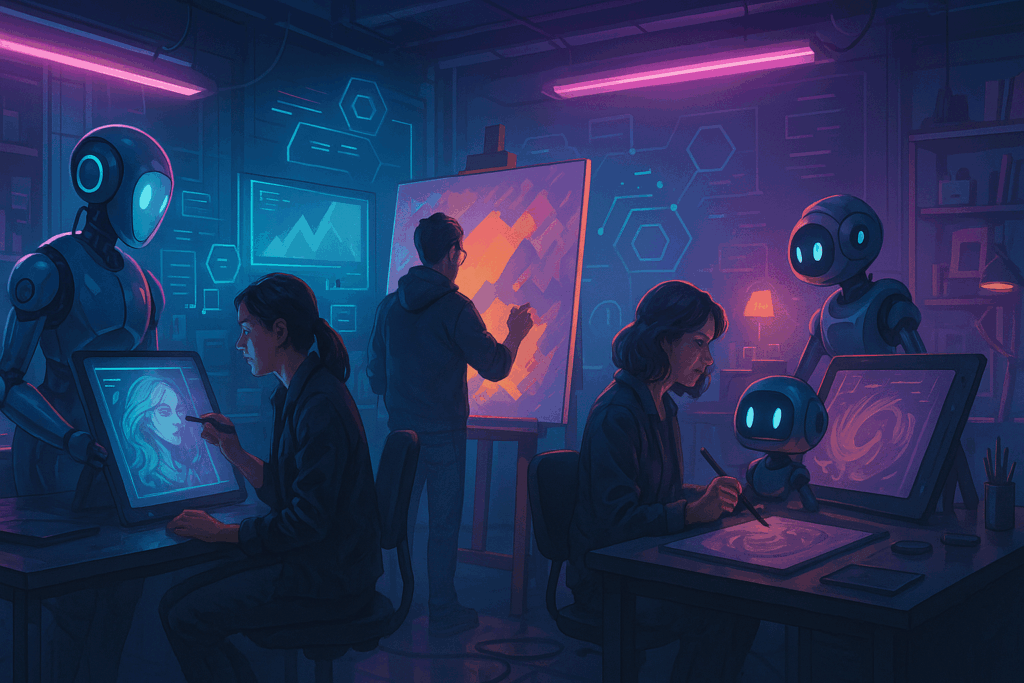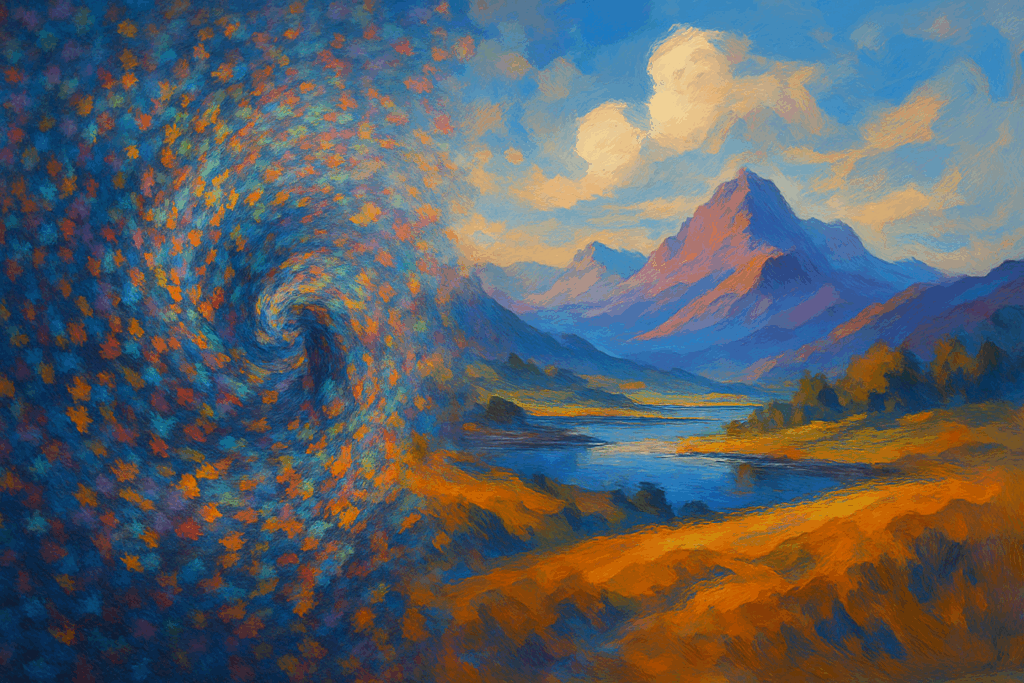In the past few years, we’ve witnessed an explosion in AI’s ability to create images from text descriptions. Remember when making a picture meant picking up a camera or a paintbrush? Now, you can simply tell a computer what you imagine, and watch it generate a fitting image. This technology is moving fast – not just in labs, but in real-world apps and creative studios. It’s powered by two major AI approaches: diffusion models (the engines behind tools like FLUX and Stable Diffusion) and newer autoregressive transformers that can handle images (like the latest GPT-4o). In this post, we’ll explore both, see how they work at a high level, and discuss how they’re changing creative workflows and society at large. We’ll look at current applications in marketing, gaming, education, and accessibility, and even speculate on future opportunities and risks. Whether you’re a casual reader or a tech enthusiast, let’s dive into this fascinating convergence of image generation and language AI.

Diffusion Models: Teaching AI to Paint with Noise
The first wave of AI image generators hitting the mainstream were largely based on diffusion models. These models, like Stable Diffusion, Midjourney, and DALL·E 2/3, introduced the world to AI “painting” stunning visuals from text prompts. But how do they work? In simple terms, a diffusion model learns to create pictures by reversing a noise process. Imagine starting with a canvas of pure static – like the “snow” on an old TV. The AI has been trained on millions of images with their descriptions, so it knows how images relate to text. It gradually de-noises that static, step by step, until a clear image emerges that matches the description you gave. It’s a bit like watching a photo come into focus from a blur. Each step of the diffusion process adds a little more detail, guided by the patterns the AI learned during training.
This approach has proven incredibly effective. Diffusion models excel at generating high-quality, detailed, and diverse images. Stable Diffusion, for example, was released as open-source in 2022 and quickly became a go-to tool for artists and developers. It runs the diffusion process in a latent space (a compressed version of images), which makes it relatively efficient on consumer GPUs. Suddenly, anyone with a decent PC could generate artwork, posters, game textures – you name it – just by typing a description. Communities sprang up to share prompts (text formulas) that yielded the best results. Terms like “prompt engineering” entered the lexicon of digital art, as people learned which words or styles to include to coax the AI toward a desired look.
FLUX is one of the latest stars in the diffusion world. Launched in mid-2024 by Black Forest Labs (a team founded by former Stability AI researchers), FLUX.1 is essentially a next-generation Stable Diffusion. It aims to produce even more coherent and high-fidelity images, with improvements in how it handles fine details and complex scenes. Early users noted that FLUX could generate images with striking visual fidelity – for instance, getting hands and faces (long-time pain points in AI art) more accurate than prior models. While Stable Diffusion and its successors focus on photorealism and creativity, other diffusion variants have specialized roles too. OpenAI’s DALL·E 3 (introduced in late 2023) uses diffusion under the hood but was tightly integrated into ChatGPT for easier use. Adobe’s Firefly model, also diffusion-based, powers the “generative fill” in Photoshop, enabling designers to extend images or remove objects with a single prompt. This mainstream adoption shows how diffusion models have already changed creative workflows – tasks that once took skilled Photoshop work can now be done by anyone in seconds, just by asking the AI.
Real-world applications of diffusion models are everywhere. Marketing teams use them to whip up concept images for campaigns before committing to costly photo shoots. For example, an ad agency can generate dozens of product mockups with different backgrounds and lighting to test ideas, without hiring a photographer for each variant. Game studios and filmmakers leverage diffusion tools to visualize characters and scenes during brainstorming – imagine being able to see a rough concept of a fantasy landscape just by describing it in words. Social media is awash with AI-generated art from hobbyists and professionals alike, creating everything from book covers to music album art. Even magazine covers have experimented with AI art. (In one notable case, Cosmopolitan’s June 2022 cover was an AI-generated astronaut, a milestone for AI in editorial design.) All of this has been possible thanks to diffusion models translating our imaginative ideas into pixels.
Despite their power, diffusion models typically function as separate tools – you input a text prompt, hit “generate,” and get an image. If it’s not quite right, you tweak the prompt or adjust some settings (like adding a “negative prompt” to avoid unwanted elements) and try again. It’s a bit of a trial-and-error dance, and mastering it can be an art in itself. This is where the next development is changing things: bringing image generation into a conversational loop with autoregressive transformers.

Autoregressive Transformers: When Language Models Learn to Draw
The year 2025 has introduced a new twist in AI image generation – models that generate images using the same autoregressive techniques that powered large language models. In plain language, autoregressive models build content step by step, predicting the next part based on what’s already produced. This is how GPT-like language AIs generate text (one word at a time). Now, that concept is being applied to images: the AI generates an image one piece at a time, rather than refining noise globally as diffusion does.
OpenAI’s GPT-4o update is a prime example. In a recent update to ChatGPT (sometimes nicknamed GPT-4 “vision” or GPT-4o), OpenAI enabled native image generation within the chat interfacemedium.com. You can prompt ChatGPT not just to write or answer questions, but to create an image for you, and it will draw it in front of your eyes (in a manner of speaking). Under the hood, GPT-4o uses a transformer-based autoregressive image model. What does that mean? Essentially, the model breaks an image into a sequence of tiny units or “tokens” – these could be little patches of pixels or symbols representing colors and shapes. It then uses its transformer architecture (the same kind of network that powers GPT’s understanding of context) to predict those tokens one by one, in the right order, to form a complete image.
Think of it like the AI is painting by numbers or assembling a jigsaw puzzle piece by piece, always looking at the pieces it’s already placed to decide what comes next. This sequential approach ensures consistency: for example, if the AI has drawn a sun in the top-left corner, it will remember that when it’s coloring the sky around it, ensuring the lighting and shadows match. Each new “token” it adds is informed by all the prior ones, much like how when writing a sentence, a language model ensures each next word fits the context of the previous words. The result is an image constructed with a sort of logical flow from start to finish.
Why is this a big deal? For one, it brings image generation into the same realm as chat. Instead of using separate software or websites for making images, you can now do it in a conversational way. Autoregressive image models like GPT-4o are also showing some advantages in certain areas. They tend to handle complex prompts and multimodal interactions very well. Because the model behind it is a powerful language model that has learned a lot about the world (from text and images), you can ask for a very detailed or abstract scene and it will try to honor every element of the description. Early users have found that this approach can produce images with very precise elements – for instance, rendering readable text within an image (like a storefront sign or a book cover) more reliably than diffusion models could. This makes sense, as the transformer generating the image letter-by-letter can ensure the text is formed correctly, whereas diffusion often jumbled letters.
Autoregressive models also naturally lend themselves to multimodal tasks. GPT-4 already had the ability to understand images as input (you could show it a picture and ask questions about it). With generation in the mix, we inch closer to an AI that can fluidly mix vision and language both ways – you could imagine feeding an initial sketch or reference image and a prompt, and the AI transformer refines or extends it with a dialogue. Some research projects are pointing in this direction. For instance, a 2024 paper introduced LlamaGen, which repurposed Meta’s Llama language model to generate images token-by-token and achieved results rivaling diffusion models. In fact, that research demonstrated that with enough training and scale, a vanilla transformer (no special image tweaks beyond a tokenizer) could reach state-of-the-art image quality. In short, transformers are showing they can do the heavy lifting in image generation just as they did with text.
It’s worth noting that this transformer-based image generation is still new, and there are trade-offs. One big challenge is speed: creating an image one token at a time can be slower than the parallel process of diffusion. Users have noticed that GPT-4o might take upwards of a minute to draw a high-resolution image from scratch, whereas diffusion models can often do it in seconds on a good GPU. There are also some kinks being worked out in terms of image size and consistency – for example, very large images might come out with some awkward tiling or cropping issues in early versions of these models. However, these are likely to improve with optimization (indeed, the same paper above showed techniques to speed up transformer image generation by over 3x with model serving tweaks). The fact that this is possible at all is exciting, because it means image generation can be more tightly integrated with language understanding and dialogue.

